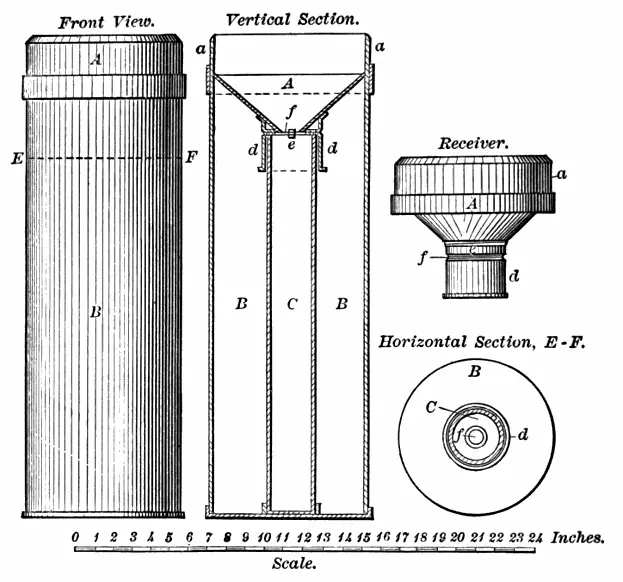Robert DeCourcy Ward - Practical Exercises in Elementary Meteorology
Здесь есть возможность читать онлайн «Robert DeCourcy Ward - Practical Exercises in Elementary Meteorology» — ознакомительный отрывок электронной книги совершенно бесплатно, а после прочтения отрывка купить полную версию. В некоторых случаях можно слушать аудио, скачать через торрент в формате fb2 и присутствует краткое содержание. Жанр: foreign_antique, Физика, foreign_edu, на английском языке. Описание произведения, (предисловие) а так же отзывы посетителей доступны на портале библиотеки ЛибКат.
- Название:Practical Exercises in Elementary Meteorology
- Автор:
- Жанр:
- Год:неизвестен
- ISBN:нет данных
- Рейтинг книги:4 / 5. Голосов: 1
-
Избранное:Добавить в избранное
- Отзывы:
-
Ваша оценка:
- 80
- 1
- 2
- 3
- 4
- 5
Practical Exercises in Elementary Meteorology: краткое содержание, описание и аннотация
Предлагаем к чтению аннотацию, описание, краткое содержание или предисловие (зависит от того, что написал сам автор книги «Practical Exercises in Elementary Meteorology»). Если вы не нашли необходимую информацию о книге — напишите в комментариях, мы постараемся отыскать её.
Practical Exercises in Elementary Meteorology — читать онлайн ознакомительный отрывок
Ниже представлен текст книги, разбитый по страницам. Система сохранения места последней прочитанной страницы, позволяет с удобством читать онлайн бесплатно книгу «Practical Exercises in Elementary Meteorology», без необходимости каждый раз заново искать на чём Вы остановились. Поставьте закладку, и сможете в любой момент перейти на страницу, на которой закончили чтение.
Интервал:
Закладка:
The wind vaneused by the Weather Bureau is about 6 feet long, and has a divided tail made of pine boards, the two pieces making an angle of 22 1⁄ 2°. The purpose of this divided tail is to steady the vane and to make it more sensitive to light currents.

Fig. 3.
A common wind vane on a neighboring church steeple or flagstaff will usually serve sufficiently well for ordinary use. Observations of wind direction (to eight compass points) are to be made as a part of the ordinary weather record, and to be entered in the proper column of the record book.
The rain gaugeconsists of three separate parts, the receiver A , the overflow attachment B , and the measuring tube C .

Fig. 4.
The inside diameter of the top of the receiver in the standard Weather Bureau gauge is 8 inches (at a in Fig. 4). This receiver has a funnel-shaped bottom, so that all the precipitation which falls into it is carried at once into the measuring tube C , whose inside height is 20 inches. The diameter of the measuring tube is 2.53 inches. The rain falling into the receiver A fills this tube C to a depth greater than the actual rainfall, in proportion as the area of the receiver is greater than the area of the measuring tube. In the standard Weather Bureau gauges the ratio of the area of the receiver to the area of the measuring tube is such that the depth of rainfall is magnified exactly ten times. The object of magnifying the amount in this way is to measure a very small quantity more easily. The narrow portion of the receiver [ d ] fits over the top of the measuring tube, holding the latter firmly in place and preventing any loss of rainfall. An opening, e , in the lower portion of the receiver [ d ], just on a level with the top of the measuring tube, serves as an escape for the water into the overflow attachment B , in case the rainfall is so heavy as to more than fill the tube. The inside diameter of the overflow attachment is the same as that of the receiver (8 inches), as will be seen from the figure.
The rain gauge should be firmly set in a wooden frame, so arranged that the overflow attachment can readily be removed from the frame. The box in which the gauge is sent out by the manufacturer is usually designed to serve as a permanent support when the gauge is set up. The best exposure for the gauge is an open space unobstructed by large trees, buildings, or fences. Fences, walls, or trees should be at a distance from the gauge not less than their own height. If an exposure upon the ground is out of the question, the gauge may be placed upon a roof, in which case the middle of a flat unobstructed roof is the best position.
Records of Rainfall.—Every rain gauge is provided with a measuring stick, which is graduated into inches and hundredths. It must be remembered that the amount of rain in the measuring tube is, by the construction of the ordinary gauge, ten times greater than the actual rainfall. This fact need not, however, be taken into account by the observer, for the numbers used in graduating the measuring sticks have all been divided by 10, and therefore they represent the actual rainfall. The graduations on the stick indicate hundredths of an inch, and should appear in the record as decimals (.10, .20, etc.). Ten inches of water in the measuring tube will reach the mark 1.00 on the stick; thus 1.00 denotes 1 inch and zero hundredths of rain. One inch of water in the tube will reach the .10 mark, indicating 10⁄ 100of an inch. The shortest lines on the measuring stick denote successive hundredths of an inch. Thus, if water collected comes to a point halfway between the .10 and .20 lines, the amount is .15 inch, and so on. In measuring rainfall, the stick is lowered through the bottom of the receiver into the measuring tube, and on being withdrawn the wet portion of the stick at once shows the depth of water in the tube. Care must be exercised to put the end of the stick where the numbering begins first into the gauge, and to pass the stick through the middle of the tube. After each observation the gauge should be emptied and drained, and immediately put back into place. When the total rainfall more than fills the measuring tube, i.e. , exceeds 2 inches, the receiver should first be lifted off and the tube removed with great care so as not to spill any water. After emptying the tube, the surplus water in the overflow attachment must be poured into the measuring tube and measured. The amount of rainfall thus found is to be added to the 2 inches contained in the measuring tube in order to give the total rainfall. If any water happens to be spilled during its removal from the overflow attachment, then the amount in the tube will be less than 2 inches, and it must be carefully measured before the latter is emptied.
During the winter season, in all regions where snow forms the chief part of the precipitation, the only portion of the rain gauge that need be exposed is the overflow attachment. The snow which falls into the gauge may be measured by first melting the snow and then measuring the water as rainfall. About 10 inches of snow give, on the average, 1 inch of water, but the ratio varies very greatly according to the density of the snow. Besides the measurement of the melted snow collected in the gauge, it is customary to keep a record of the depth of snowfall in inches, as measured by means of an ordinary foot rule or a yardstick, on some level place where there has been little or no drifting.
Measurements of rain and snowfall are usually made once a day, at 8 P.M., and also at the end of every storm. Enter the amounts of precipitation in the column of the table headed “Amount” and state always whether it is rain or melted snow that you have measured. When there has been no precipitation since the last observation, an entry of 0.00 should be made in the column of the record book devoted to “Amount of Precipitation.” When the amount is too small to measure, the entry T (for Trace ) should be made.
Continue your non-instrumental record of the time of beginning and ending of the precipitation as before. Whenever it is possible, keep a record of the total amount of precipitation in each storm, noting this under “Remarks.” Try to answer such questions as are asked in Chapter I with the help of your instrumental record of the rain and snowfall. Note what depths of snow in different snowstorms are necessary, when melted, to make 1 inch of water.
The Mercurial Barometer.—Air has weight. At sea level this weight amounts to nearly 15 pounds on every square inch of surface. Imagine a layer of water, 34 feet deep, covering the earth. The weight of this water on every square inch of surface would be the same as the weight of the air. Under ordinary circumstances the weight of the air is not noticeable, because air presses equally in all directions, and the pressure within a body is the same as that outside of it. On account of this equal pressure in all directions, we speak of the pressure of the air instead of its weight . The effects of the air pressure may become apparent when we remove the air from a surface. By working the piston of a pump in a well we may remove the pressure on the surface of the water in the tube of the pump. When this is done, a column of water rises in the tube until the top of this column is about 34 feet above the level of the rest of the water in the well. The pressure of the atmosphere on the water outside of the tube holds up this column of water inside the tube.
Читать дальшеИнтервал:
Закладка:
Похожие книги на «Practical Exercises in Elementary Meteorology»
Представляем Вашему вниманию похожие книги на «Practical Exercises in Elementary Meteorology» списком для выбора. Мы отобрали схожую по названию и смыслу литературу в надежде предоставить читателям больше вариантов отыскать новые, интересные, ещё непрочитанные произведения.
Обсуждение, отзывы о книге «Practical Exercises in Elementary Meteorology» и просто собственные мнения читателей. Оставьте ваши комментарии, напишите, что Вы думаете о произведении, его смысле или главных героях. Укажите что конкретно понравилось, а что нет, и почему Вы так считаете.












